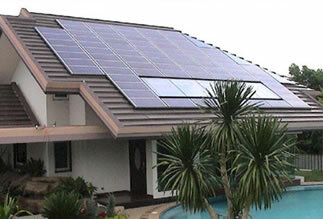we call renewable energy any and all types of energy that originates from some natural source such as water (hydraulic energy), the sun (solar energy), the wind (wind energy), the movement of waves (tidal energy), a geothermal energy and the biomass energy. All these types of energy are renewable, that is, they do not run out and do not release pollutants into the atmosphere. Below, let's know a little more about the types of renewable energy.
Hydraulic energy

Hydraulic energy is produced from river water
Widely used throughout the world, and especially in Brazil, due to the number of rivers, the hydraulic energy it is produced from hydroelectric plants built on rivers. When building a dam on a river, it is necessary to interrupt the normal course of the river, and later on, create a reservoir. This reservoir will fill with water and, as the water leaves the reservoir, it will pass through turbines, operating an electrical generator that will produce energy.
All the energy produced goes through transmission lines and power stations until it reaches our homes, where will be used in electronics, such as refrigerators, computers, televisions, lamps, showers, etc.

Transmission lines and power stations are used to transmit energy to our homes, businesses, industries, etc.
It is very important to remember that even though it is renewable energy, and it does not pollute, we must always save it, using it conscientiously, avoiding leaving appliances and light bulbs on for no reason.
Solar energy

Solar energy is obtained through sunlight
As it is an energy that has a very high cost in its implementation, the solar energy it is still little used to generate energy on a large scale. It is considered renewable because it is energy obtained by sunlight, which can be absorbed through the solar collector, solar concentrator or solar panel. Through these technologies, sunlight is transformed into energy. Many people use the solar energy at home, as a way to save and use energy from the sun.

House with solar panels to capture sunlight
wind energy

Image showing a wind turbine, responsible for capturing wind energy
Still little used in the world, the wind energy is the energy generated from the wind. Man has been using this energy for many years to move his boats; and also in windmills, used to grind grain.
for the wind energy is produced, it is necessary that the wind turbines (large turbines in the shape of a vane) are installed in open places and with a large amount of wind. As the propellers move, they produce energy captured by a generator, generating electricity.

windmill
Tidal Energy

The tidal energy is obtained through the movements of the waves of the sea.
THE tidal energy it is achieved through the movements of sea waves and tides, due to the force of gravity that exists between the Moon, Earth and Sun, which causes the tides. In order to capture this energy, it is necessary to build a dam forming a reservoir near the sea. When the tide fills up, becoming high, seawater fills the turbines generating energy, similar to hydraulic energy. The cost of setting up a plant like this is very expensive, but it is believed that this type of energy will be used a lot in the future.
Geothermal energy

Geothermal plant uses energy that comes from within the earth
Also called geothermal energy, a geothermal energy is generated from the energy that comes from the interior of the earth, since there the heat can reach up to 50000C, producing very hot water and a lot of steam. In the geothermal plant, water and steam are used to drive the turbines, thus being transformed into electricity.
biomass energy

Biomass energy is generated by organic materials such as food waste, wood, manure, etc.
To understand how this energy works, you first need to know what it is biomass. We call biomass all material of organic origin. When these materials (such as manure, wood, food waste, etc.) decompose, they produce a gas called methane and it is this gas that is responsible for the production of biomass energy. This type of energy production, in addition to being renewable and non-polluting, can also contribute to reducing the greenhouse effect and global warming. Some plants that produce ethanol fuel produce this type of energy from sugarcane bagasse.
By Paula Louredo
Graduated in Biology



